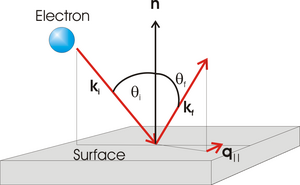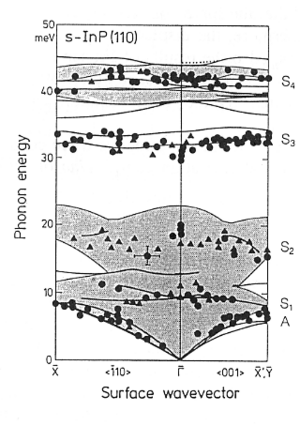Surface phonons
Surface phonons and vibrations
Electrons which are scattered from a surface can partly loose their energy by exciting local vibrations. With angle-resolved high-resolution energy loss spectroscopy the excitation energy can be measured as a function of the the parallel wavevector. In Fig. 1 the principle of such inelastic scattering experiments is shown. Incoming electrons are scattered off-specular exciting local vibrations with energy E(q||). The dispersion curves E(q||) reveal the nature of the vibration and the coupling between different oscillators.

Fig 1.: The principle of inelastic electron scattering from surfaces exciting a local vibration with energy E(q||)

Fig 2.: Dispersion of InP(110) surface phonons. The symbols represent the experimental data whereas the solid lines are calculated from first principles (J. Fritsch et al., Phys. Rev. B 52 (1995) 11326). The shaded areas are calculated bulk phonon bands projected onto the surface Brillouin zone. In the total band gap of the bulk phonon spectrum, modes of surface localized vibrations are found
An example of localized vibrations at a surface is presented in Fig. 2 where the experimental and theoretical dispersion of InP(110) surface phonons is plotted. The shaded areas are calculated bulk phonons projected onto the surface Brillouin zone. There is a total band gap between optical and acoustic bulk phonons in InP. Within the band gap surface modes with little dispersion are measured which are in excellent agreement with ab initio calculations (J. Fritsch et al., Phys. Rev. B 52 (1995) 11326). These modes have displacement patterns where only the top two or three atom layers are involved.
